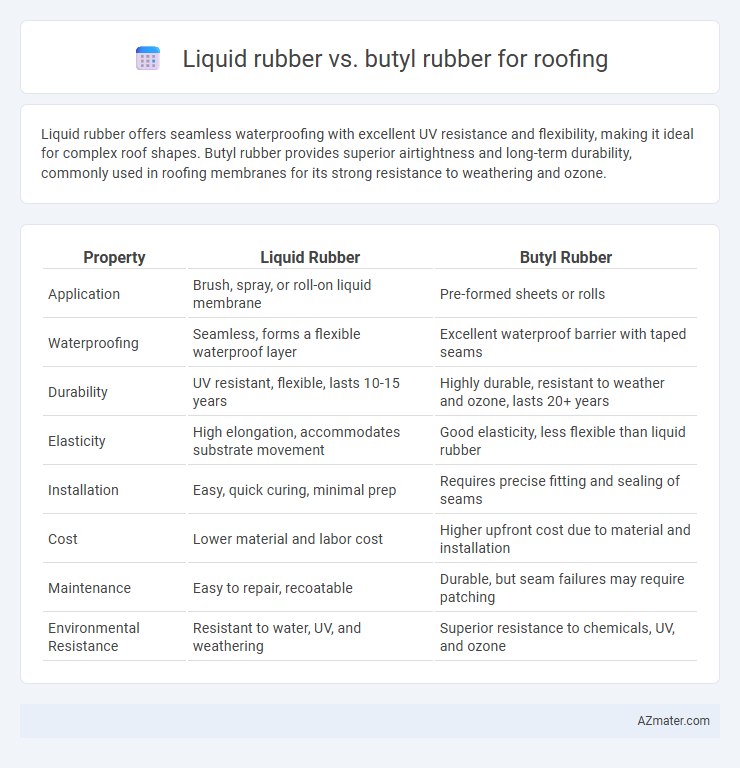Liquid rubber offers seamless waterproofing with excellent UV resistance and flexibility, making it ideal for complex roof shapes. Butyl rubber provides superior airtightness and long-term durability, commonly used in roofing membranes for its strong resistance to weathering and ozone.
Table of Comparison
| Property | Liquid Rubber | Butyl Rubber |
|---|---|---|
| Application | Brush, spray, or roll-on liquid membrane | Pre-formed sheets or rolls |
| Waterproofing | Seamless, forms a flexible waterproof layer | Excellent waterproof barrier with taped seams |
| Durability | UV resistant, flexible, lasts 10-15 years | Highly durable, resistant to weather and ozone, lasts 20+ years |
| Elasticity | High elongation, accommodates substrate movement | Good elasticity, less flexible than liquid rubber |
| Installation | Easy, quick curing, minimal prep | Requires precise fitting and sealing of seams |
| Cost | Lower material and labor cost | Higher upfront cost due to material and installation |
| Maintenance | Easy to repair, recoatable | Durable, but seam failures may require patching |
| Environmental Resistance | Resistant to water, UV, and weathering | Superior resistance to chemicals, UV, and ozone |
Introduction to Liquid Rubber and Butyl Rubber Roofing
Liquid rubber roofing provides a seamless, waterproof membrane with excellent elasticity and UV resistance, making it ideal for irregular surfaces and easy application through spraying or brushing. Butyl rubber roofing, derived from butyl elastomers, offers superior durability, chemical resistance, and low permeability, ensuring long-term protection against water infiltration and weathering. Both materials enhance roof longevity, but liquid rubber excels in flexible, quick applocations while butyl rubber is preferred for high-performance, heavy-duty roofing systems.
Composition and Material Properties
Liquid rubber is a synthetic elastomer typically composed of nitrile or acrylic polymers offering superior flexibility, UV resistance, and seamless application for roofing. Butyl rubber, a copolymer of isobutylene and isoprene, provides excellent impermeability to gases and outstanding durability against weathering, making it highly resistant to water and air infiltration. The chemical composition of liquid rubber enables easy surface adhesion and rapid curing, while butyl rubber's dense molecular structure ensures long-lasting waterproofing and elasticity under temperature fluctuations.
Installation Process: Liquid Rubber vs Butyl Rubber
Liquid rubber offers a seamless, quick application process through brush, roller, or spray, creating a flexible and waterproof membrane that adheres directly to varied roof surfaces without the need for primers or fasteners. Butyl rubber, typically available in sheets or rolls, requires more labor-intensive installation involving careful cutting, alignment, and fastening with adhesives or mechanical fasteners to ensure a watertight seal. The liquid rubber's curing time ranges from a few hours to a day, allowing faster project completion compared to the longer setup and securing time necessary for butyl rubber roofing systems.
Durability and Lifespan Comparison
Liquid rubber offers outstanding flexibility and UV resistance, resulting in a lifespan of 15 to 20 years when properly applied on roofing surfaces. Butyl rubber excels in tear resistance and impermeability, providing exceptional durability with a typical lifespan of 20 to 25 years in roofing applications. Both materials ensure long-term protection, but butyl rubber generally delivers a longer service life due to its superior resilience against environmental stressors.
Waterproofing and Leak Protection
Liquid rubber offers superior waterproofing performance with seamless application that forms a flexible, durable membrane, effectively sealing roof surfaces and preventing water infiltration. Butyl rubber is highly resistant to water and provides excellent leak protection due to its strong adhesion and elongation properties, making it ideal for roof repairs and long-term durability. Both materials excel in waterproofing; however, liquid rubber's ability to cover complex roof geometries without seams provides enhanced protection against leaks.
Flexibility and Crack Resistance
Liquid rubber offers superior flexibility compared to butyl rubber, allowing it to expand and contract with temperature fluctuations without losing integrity. Its enhanced crack resistance makes it ideal for roofing applications exposed to harsh weather conditions, reducing the risk of leaks and structural damage. Butyl rubber, while resistant to air and moisture, is less flexible and more prone to cracking under prolonged stress or extreme temperatures.
Cost Analysis: Upfront and Long-Term
Liquid rubber roofing typically offers a lower upfront cost compared to butyl rubber due to simpler application and reduced labor requirements. Butyl rubber, while more expensive initially, provides enhanced durability and superior weather resistance, leading to lower long-term maintenance and replacement expenses. Evaluating total cost of ownership reveals liquid rubber as budget-friendly short-term, whereas butyl rubber delivers better long-term value through extended roof lifespan.
Maintenance Requirements and Ease of Repair
Liquid rubber roofing requires minimal maintenance due to its seamless, flexible membrane that resists cracking and peeling, reducing repair frequency. Butyl rubber, while durable, may develop seams and joints that need regular inspection and occasional patching to prevent leaks. Repairs on liquid rubber systems are straightforward and quick, involving simple re-coating, whereas butyl rubber repairs often demand more extensive work to address seam-related issues.
Environmental Impact and Sustainability
Liquid rubber roofing materials are often favored for their low environmental impact due to their ability to extend roof lifespan and reduce waste through seamless, durable coatings made from recyclable or water-based components. Butyl rubber, while offering excellent durability and weather resistance, is typically derived from synthetic petrochemicals with less biodegradability and a higher carbon footprint during production. When prioritizing sustainability, liquid rubber's formulation and application process generally result in fewer emissions and enhanced recyclability compared to traditional butyl rubber membranes.
Final Verdict: Choosing the Best Rubber Roofing Solution
Liquid rubber offers superior flexibility and seamless application, making it ideal for roofs with complex shapes or frequent temperature fluctuations. Butyl rubber excels in durability and UV resistance, providing long-lasting protection for flat or low-slope roofs exposed to harsh weather conditions. Selecting the best rubber roofing solution depends on specific project needs, with liquid rubber favored for ease of installation and conformity, while butyl rubber is preferred for maximum weather resilience and lifespan.

Infographic: Liquid rubber vs Butyl rubber for Roofing
 azmater.com
azmater.com